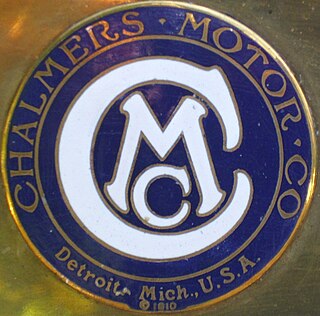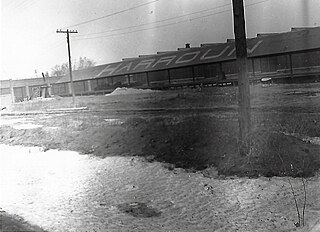Related Research Articles

The Ford Model T is an automobile that was produced by Ford Motor Company from October 1, 1908, to May 26, 1927. It is generally regarded as the first affordable automobile, which made car travel available to middle-class Americans. The relatively low price was partly the result of Ford's efficient fabrication, including assembly line production instead of individual handcrafting.

Hupmobile was an automobile built from 1909 through 1939 by the Hupp Motor Car Company of Detroit. The prototype was developed in 1908

Chalmers Motor Company was an American car company headquartered in Detroit, Michigan. The company started in 1908 and continued producing high-end vehicles until 1923, when it merged with Chrysler.

The Saxon Motor Car Company was located in Detroit, Michigan, from 1914 to 1922. In 1917, 28,000 cars were made, making it the seventh largest car maker in the United States.

Albert Kahn was an American industrial architect. He was accredited the architect of Detroit and designed industrial plant complexes such as the Ford River Rouge automobile complex. He designed the construction of Detroit skyscrapers and office buildings as well as mansions in the city suburbs. He led an organization of hundreds of architect associates and in 1937, designed 19% of all architect-designed industrial factories in the United States. Under a unique contract in 1929, Kahn established a design and training office in Moscow, sending twenty-five staff there to train Soviet architects and engineers, and to design hundreds of industrial buildings under their first five-year plan. They trained more than 4,000 architects and engineers using Kahn's concepts. In 1943, the Franklin Institute posthumously awarded Kahn the Frank P. Brown Medal.

The Essex was a brand of automobile produced by the Essex Motor Company between 1918 and 1922, and by Hudson Motor Car Company of Detroit, Michigan between 1922 and 1933.

Ransom Eli Olds was a pioneer of the American automotive industry, after whom the Oldsmobile and REO brands were named. He claimed to have built his first steam car as early as 1887 and his first gasoline-powered car in 1896. The modern assembly line and its basic concept is credited to Olds, who used it to build the first mass-produced automobile, the Oldsmobile Curved Dash, beginning in 1901.

Rickenbacker Motor Company was a US automobile manufacturer located in Detroit, Michigan, from 1922 until 1927.

The Highland Park Ford Plant is a former Ford Motor Company factory located at 91 Manchester Avenue in Highland Park, Michigan. It was the second American production facility for the Model T automobile and the first factory in history to assemble cars on a moving assembly line. It became a National Historic Landmark in 1978.

The Terraplane was a car brand and model built by the Hudson Motor Car Company of Detroit, Michigan, between 1932 and 1938. In its maiden year, the car was branded as the Essex-Terraplane; in 1934 the car became simply the Terraplane. They were inexpensive, yet powerful vehicles that were used in both town and country. The Terraplane name was used for both cars and trucks.

The Ford Piquette Avenue Plant is a former factory located within the Milwaukee Junction area of Detroit, Michigan, in the United States. Built in 1904, it was the second center of automobile production for the Ford Motor Company, after the Ford Mack Avenue Plant. At the Piquette Avenue Plant, the company created and first produced the Ford Model T, the car credited with initiating the mass use of automobiles in the United States. Prior to the Model T, several other car models were assembled at the factory. Early experiments using a moving assembly line to make cars were also conducted there. It was also the first factory where more than 100 cars were assembled in one day. While it was headquartered at the Piquette Avenue Plant, Ford Motor Company became the biggest U.S.-based automaker, and it would remain so until the mid-1920s. The factory was used by the company until 1910, when its car production activity was relocated to the new, bigger Highland Park Ford Plant.

The Dort Motor Car Company of Flint, Michigan, built automobiles from 1915–1924. Dort used Lycoming-built engines to power their vehicles.

Barley Motor Car Co. was a manufacturer of automobiles in Kalamazoo, Michigan, and Streator, Illinois. It manufactured the Roamer automobile (1916–29) and, briefly, the Barley (1922–24), and the Pennant (1924–25).

The Bour-Davis was an American automobile manufactured from 1916 until 1922. The car took its name from two of the founders of the company; Robert C Davis and Charles J Bour. Production of the car was started in Detroit, before moving to Frankfort, Indiana, in 1918. A distinctive feature of the Model 17 and Model 18B cars built in Detroit and Frankfort was the slightly slanted and pointed radiator. Prices ranged from $1250 to $1500 in 1916, rising to $1650 in 1919.

The Earl was an automobile manufactured in Jackson, Michigan by Earl Motors Incorporated from 1921 to 1923. The Earl was a continuation of the Briscoe. The Model 40 offered both open and closed models with a four-cylinder engine. Approximately 2,000 vehicles were produced. When the Earl debuted in 1921, the tourer cost just $1285. The company also claimed that $100 worth of "extras", such as linoleum floor boards and carpets front and rear were included in the base price.

The Harroun was an automobile manufactured in Wayne, Michigan by the Harroun Motor Sales Corporation from 1916 to 1920. The company bore the name of its founder, racing legend Ray Harroun, who in 1911 won the first Indianapolis 500 Sweepstakes.

Daniels Motor Company was a pioneer brass era American automobile company, founded in 1915 by George E. Daniels with Neff E. Parish.George Daniels was a known lawyer, engineer, and mechanic. He was considered the best motorcar designer in the United States. Neff Parish had his own automobile parts and framing manufacturing company. Neff was the creator of the time's highest-grade heat-treated alloy steel frames, respected in the steel industry. Daniels Motor Company produced 1,500 high quality automobiles between 1916-1924, branding themselves as “the distinguished car with just a little more power than you will ever need”, and “The aristocrat of American cars”.

The Flanders Automobile Company was a short-lived US-American automobile manufacturer which operated in Detroit, Michigan, from 1910 to 1913. Its only product was sold through Studebaker dealerships.

Willys was a brand name used by Willys–Overland Motors, an American automobile company, founded by also diplomat John North Willys, best known for its design and production of World War II era and later military jeeps (MBs), as well as civilian versions, and branding the 'jeep' military slang-word into the '(Universal) Jeep' marque, during the 20th century.